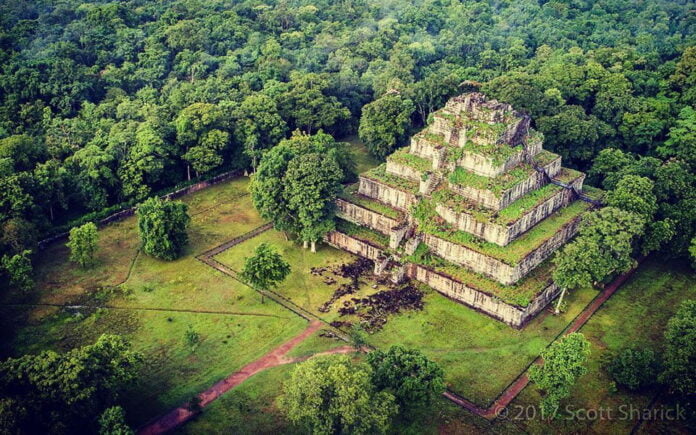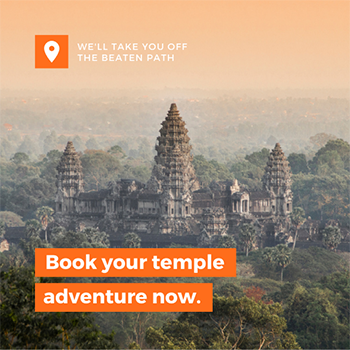The city of Koh Ker was the capital of the Khmer Empire between 928 AD and 944AD during the reigns of Jayavarman IV and Harshavarman II. Imagine this ancient city as it was – a thriving, busy hub – as you explore the now dilapidated carved sandstone rubble that would once have been home to over 10,000 inhabitants. An unusual seven-tiered pyramid structure, named Prang, nestled in ever-encroaching jungle and yet towering proudly at 36 metres high, dominates this lesser-known archaeological site, lying around 120 km north east of Siem Reap.
Enter through the imposing sandstone entrance pavilion and pass two laterite towers, now moss-covered ruins. What were once meditation or prayer ‘palaces’ built for noble kings can be seen on the eastern side, along with temple complex Prasat Thom, complete with its moat. The pyramid itself, situated in the western side of the complex, is thought to have been the state temple. A wooden staircase with handrail has been built to allow visitors to climb to all but the top tier. The seventh tier is believed to be where a plinth originally supported a four metre high linga honouring Hindu deity, Shiva. The views from the highest point are spectacular – forest as far as the eye can see.
Owing to this sparsely populated and forested region’s remoteness, the surrounding areas have yet to be cleared of mines, making only a dozen of the ancient city’s now forest-ravaged 184 monuments accessible to visitors. This makes a visit to Koh Ker feel like stumbling upon a secret, with fewer crowds and very little tourist infrastructure to cater for large groups. You might find just a handful of visitors here, which allows you to explore the crumbled and weather-beaten remains at your own pace.
Among the many smaller monuments found in Koh Ker, Prasat Bram (literally translated as “five temples”) is a real highlight, consisting of 5 brick towers, of which 2 completely overgrown by strangler figs.
How to get there
Arrange a private taxi to Koh Ker. The pleasant 2.5 hour drive from Siem Reap takes you along decent roads with views of cashew and banana plantations and rice fields along the way. The Kulen mountain route can be easily combined with a visit to Koh Ker and Beng Mealea.
Just inside the car park at Koh Ker, you’ll find restaurants, drinks kiosks and a small selection of market stalls selling fresh coconut drinks and souvenirs. There are no rest rooms here.
When to visit
Morning visits afford visitors some relief from hot sun, because the pyramid itself, and the climb up its tiers, are not shaded by trees. If you are combining your visit with a trip to Beng Mealea, it works well to visit Koh Ker first, to take advantage of the cool, before arriving at Beng Mealea around the time the large tour groups are busy taking their lunch break.
Although you’re unlikely to find large numbers of visitors here, even in high season, you can be sure of a more leisurely stroll around the site during the quieter months of May to November.
Entrance fee
Tickets for Koh Ker ($15 adults, children under 12 years go free) can be purchased at the ticket booth entrance or online. There are good bathrooms at both the ticket kiosk itself, and additionally at the ticket check point closer to Koh Ker, which also has covered picnic benches.
History
Excavation work in 2015 revealed pottery and other artefacts that hint at activity and settlement here as early as the 7th to 8th Centuries.
An important route, linking Angkor Wat with Wat Phu in Laos, also taking in Beng Mealea and Preah Vihear, ran directly past Koh Ker, giving this ancient city enduring strategic prominence.
As the area was remote, heavily forested and comparatively dry, a water supply for Koh Ker’s inhabitants came via an ambitious network of canals, water tanks and a reservoir (baray), along with the pyramid itself and 40 surrounding temples, adding to the many monuments already there. This intense construction during Jayavarman IV’s short reign was funded by taxes according to inscriptions, which indicated that these would have been paid in the form of rice.
Hindu God Shiva would have been worshipped here, and, despite the country’s later shift to Buddhism, Koh Ker’s Shiva lingas somehow remained preserved – perhaps evading orders for their demolition due to its remote location.
Architecture
With art and sculpture becoming particularly celebrated and encouraged during Jayavarman IV’s time, the site would have been rich with masterpieces.
After the site’s heyday, the sites were looted of their impressive sculptures, leaving the current site bereft of these treasures. Many have since been shown in museums or private collections but some pieces, still at large, remain classed as stolen art.
Laterite, sandstone and brick materials were used to construct Koh Ker. High quality laterite and sandstone were conveniently quarried locally and transported in large quantities, with relative ease. The brick sanctuaries in Koh Ker can be seen to be in good condition even today, thanks to the small and solid bricks used, and the organic ‘mortar’. Some Koh Ker temples’ roofs were constructed using wood and then covered with tiles.
Conclusion
An ideal day out to a site in countryside setting, with a pleasant drive and easily combined with other temple sites in the vicinity. For templed-out tourists, the unusual pyramid structure and the views from the top stand out from other sites, making it well worth the trip, which will delight everyone from young children to archaeologists at heart.



